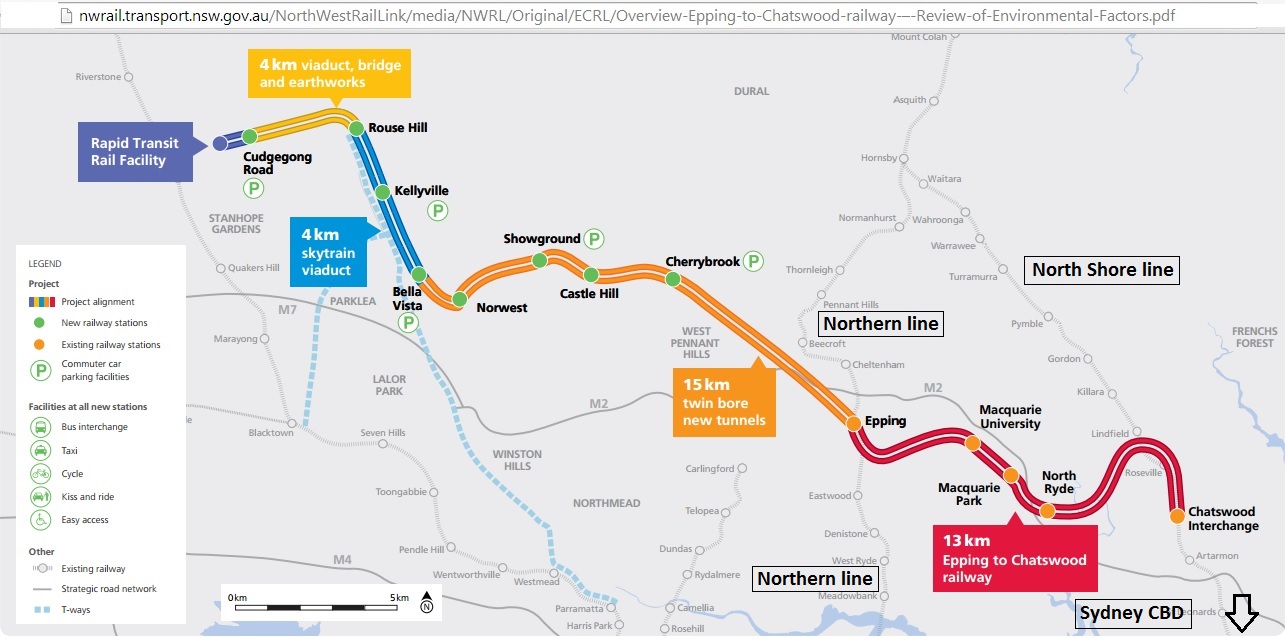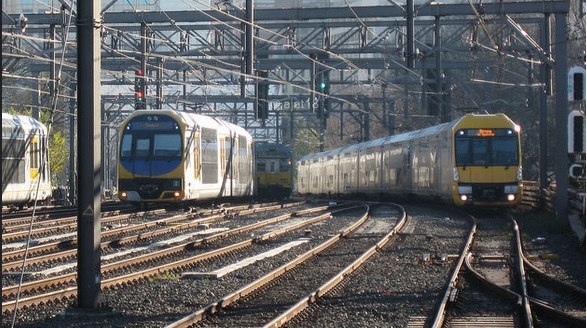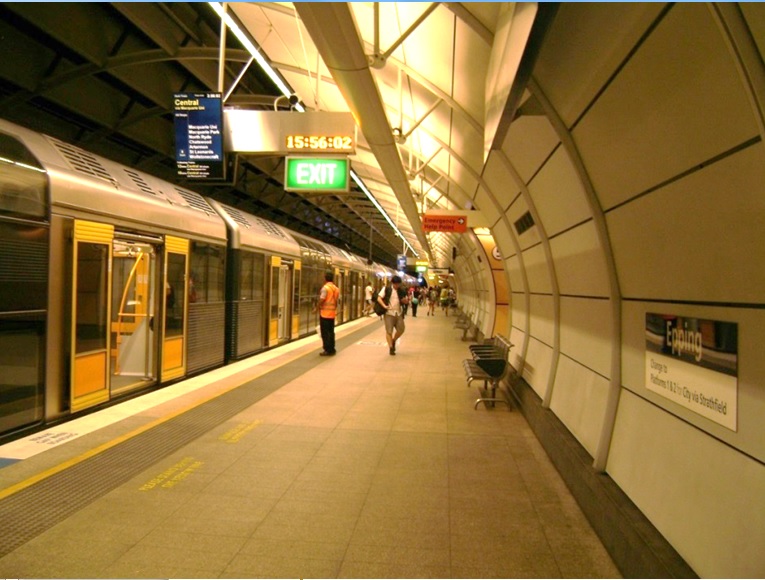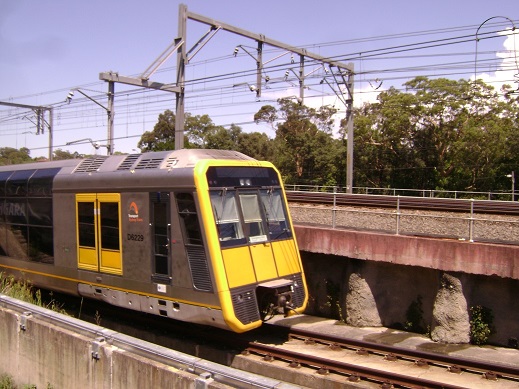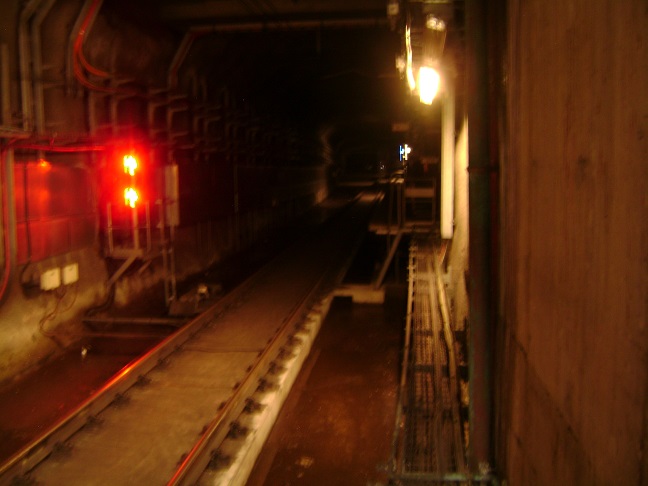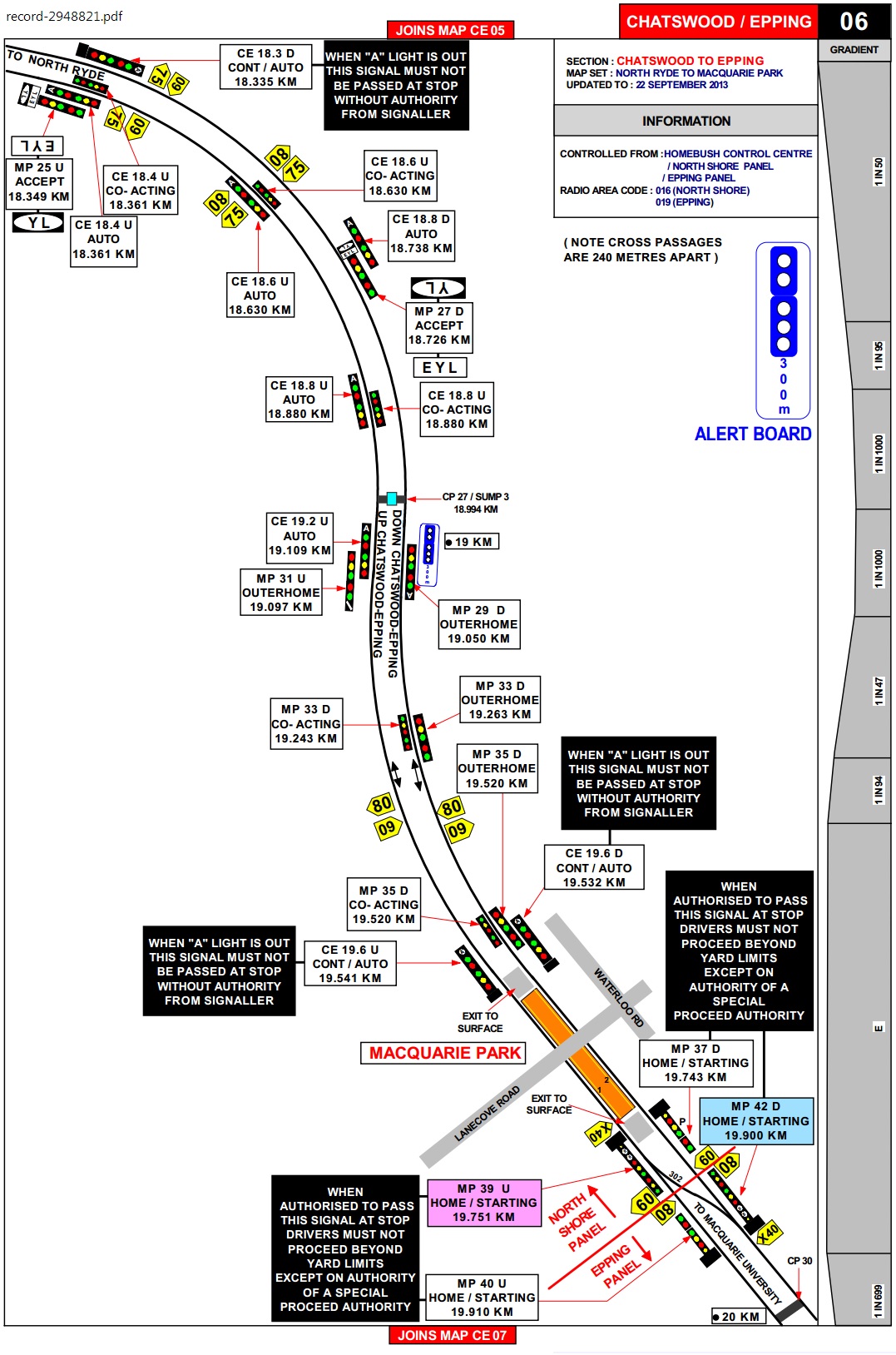Contents:
(1) Epping – Chatswood tunnel conversion works proposed
(2) Removal of tracks at Epping and Chatswood
(3) Operational flexibility reduced
(4) Removal of signalling
What can the world learn from Sydney’s future “Infrastructure Hub” established by G20 leaders in Brisbane in November 2014 and promoted in big hype by Australia’s Prime Minister Abbott who wants to become known as “Infrastructure Prime Minister”? Well, read this bizarre story:
How to disable and remove existing rail infrastructure
In year 10 of peaking oil production outside the US and Canada and while dropping oil prices indicate that the so-called US shale revolution is too expensive for the world economy, the NSW government has embarked on a risky, expensive rail project, the 23 km long North-West Rail Link (NWRL), including a 15.5 km long tunnel. In principle, rail is one of the solutions to the problem of peak oil, but not in the way it is done here.
Fig 1: Epping – Rouse Hill (NWRL, yellow and blue) is a branch line under construction, connecting to the existing tunnel Epping – Chatswood (ECRL, red) opened in 2009
The job has been given to a private operator, MTR from Hong Kong, who wants to run its own driverless metro-trains also in Sydney although the catchment area is low density and stations are far apart, not really an urban environment for metros. What’s more, these fully automatic single decker trains are absolutely incompatible with Sydney Trains’ ubiquitous double deckers and the NWRL tunnel now under construction is purposely built 50 cm too small for them.
Fig 2: Sydneysiders are used to their double deckers (here between Central and Town Hall) and will not readily accept seat poor metro trains for long-distance commuting
If the NWRL tunnel limitations were not bad enough the NSW government is handing over to MTR, on a silver platter, another 12.5 kms of existing rail tunnel, publicly funded, designed and equipped for double deckers and just opened in February 2009.
Fig 3: Double deck Tangara at Epping station underground platform 5 ready to depart for Sydney Central via Macquarie Park in December 2014.
If the NSW government has its way, you won’t see this type of train here in 2018/19.
In a recently published report, it is now proposed to downgrade this tunnel to single decker use only. This will require the closure of the tunnel for 7 months, in 2018/19, a big experiment in itself. The standalone character of the NWRL means that passengers have to change trains in Chatswood, another problem in the whole scheme.
Not only is tax payer’s money wasted but the operational flexibility of Sydney Trains in the North of Sydney is greatly reduced. What’s worse, if the private operator can’t make money the transport job will go back to Sydney Trains which then can’t run their double deckers, neither through the modified Epping-Chatswood tunnel nor through the smaller Rouse Hill – Epping tunnel
And the tunnel closure might well happen during another oil crisis which is already pre-programmed because currently lower oil prices mean reduced investments in new oil fields, urgently needed to offset decline in legacy fields. We can expect gyrating oil prices which may further damage the financial system.
While the single versus double decker issues and the tunnel diameter problems have been debated in the media ad nauseam – without the NSW government trying to find a compromise – few have realised that what is now proposed for the ECRL is NOT a smooth transition to single deckers even if that were an accepted objective. The solution would be to drop the idea of driverless trains and introduce single deckers running along with double deckers in the ECRL which will alleviate most of the above problems and spread interchange loads over 3 ECRL stations. Such single deckers could be equipped with automatic train protection (ATP level 2), backward compatible with existing signalling now in the ECRL tunnel.
(1) Conversion works proposed by NSW Government
In October 2014 the NSW government put on public exhibition the document “Epping to Chatswood Railway Conversion to Rapid Transit – Review of Environmental Factors” (REF) which proposes following work:
(1) Removal of existing Epping to Chatswood railway track connections at Epping and Chatswood to achieve operational segregation of the Epping to Chatswood railway from the Sydney Trains network
(2) Modification to the existing track network to the south of Chatswood station to allow for connection to SRT.
(3) A range of building modifications within the existing stations (Chatswood, North Ryde, Macquarie University, Macquarie Park and Epping) including:
a. Modification to platform seating, signage and other infrastructure.
b. Installation of platform safety screen doors.
c. Modifications to station rooms, signage and customer information displays.
(4) Installation of air-control units within the station precincts at Epping, Macquarie University, Macquarie Park and North Ryde.
(5) Removal of equipment in the Epping to Chatswood railway corridor that is no longer required for the future operation of the Epping to Chatswood railway as part of the rapid
transit network.
(6) Provision of new cable routes to accommodate rapid transit services and signalling systems.
(7) Modifications to systems including electrical, signalling, communications, fire and life safety, mechanical and fire systems. Modification to traction power supply.
(8) Implementation of the Epping to Chatswood Railway – Temporary Transport Plan
(9) Segregation of the existing Chatswood North substation, which
currently services the Sydney Trains network, for the future operation of the NWRL.
http://nwrail.transport.nsw.gov.au/NorthWestRailLink/media/NWRL/Original/ECRL/REF/01_Epping-to-Chatswood-Railway_Review-of-Environmental-Factos_Part-A.pdf
Let’s look at some of the work in more detail:
(2) Removal of tracks at Epping and Chatswood
These are the tracks on the dive structures in Epping connecting the twin tunnels with the Northern line:
Fig 4: Turnouts from the Northern line into the tunnel dive structures, North of Epping, 2008
http://meadowsconsulting.com.au/epping-to-chatswood-rail-link/
Left are the tracks to Chatswood, right the tracks from Chatswood. These turnout tracks and also the overhead wires will be removed. Watch these videos:
Epping – Chatswood Rail Link Video
Uploaded on Jan 10, 2011
As requested by a few people, here’s a high speed version (3 minutes) of the journey through the ECRL – Epping to Chatswood Rail Link.
https://www.youtube.com/watch?v=LMSPo_Ai7sw
Epping – Central – Hornsby
https://www.youtube.com/watch?v=pI2LMzcbc50
Fig 5: Tangara double decker going down the dive structure into the Epping-Chatswood tunnel Dec 2014.
Chatswood modifications
Fig 6: Tracks South of Chatswood station.
The centre tracks are for the ECRL, the outer tracks for the North Shore line. On the google earth view, we see a train bound for Hornsby (left) near to a stabling facility for an 8-car train.
Chatswood North substation (for traction power) is also handed over to NWRL. The April 2013 DG assessment report said nothing about it (p 4) so this was also an afterthought. It could well be that a different voltage is envisaged here, to make trains even less compatible.
(3) Operational flexibility reduced
Disconnecting the ECRL from the rest of the network reduces of course the operational flexibility of the Northern and North Shore lines. Accidents happen:
Runaway bus crashes onto rail tracks in peak hour
18 Mar 2008
With minutes to spare before a train arrived, a runaway bus [289] rolled 150 metres downhill and crashed through a fence onto train tracks near Epping station this morning, closing a large section of the Northern Sydney train line.
http://www.smh.com.au/articles/2008/03/18/1205602332228.html
Ever more ferocious storms throw trees on tracks of both Northern and North Shore lines which require trains to be diverted through the ECRL tunnel.
Peak hour delays to trains on North Shore line
8 Sep 2014
A large tree from outside the rail corridor fell on overhead lines near Killara Station just before peak hour on Monday. The disruption closed the line between Chatswood and Gordon, requiring replacement buses to service Roseville, Lindfield and Killara stations.
Central Coast & Newcastle Line trains are operating via Macquarie Park instead.
http://www.smh.com.au/nsw/peak-hour-delays-to-trains-on-north-shore-line-20140908-10e1l7.html
A diversion of double deck trains would no longer be possible
Fig 7: Intercity train to Newcastle diverted through ECRL
http://www.busaustralia.com/forum/viewtopic.php?f=42&t=69792
Worst case scenarios
- A freight train derails on the Parramatta River bridge between Meadow Bank and Rhodes and damages the bridge, requiring weeks or months for repairs. In that case, similar to interruptions by wild weather, there will be no option to run Sydney Trains’ double deckers through the ECRL.
- There is an accident with a driverless train and the public loses confidence with the system. One of the 1st priorities will be to bring the ECRL tunnel back to double decker standard
- Break-down of driverless train in tunnel. As exit and entry dive structures at Epping are without track, no emergency/rescue loco can enter the tunnel. All trains have to be removed towards Currajong as there is no space in Chatswood.
- NWRL patronage drops as surcharges to fares are introduced similar to the Airport Link. The REF document mentions vending machines on platforms in Chatswood (chapter 5.2.3 p 41). That is revealing.
(4) Removal of signalling
The ECRL control room was built just in 2008
Extract:
The ECRL Control Room is a new facility located in the Strathfield Signal Complex [now moved to Homebush]. It is a room dedicated to the function of operating the ECRL:
• 3 ATRICS workstations for Chatswood (North Shore), Epping (Main North) and North Sydney
• 3 Station Passenger Information workstations (North Shore, Main North, ECRL)
• ECRL Central Control System operator workstation
• Overview screen/s
Fig 8: Signal EG 219 D (North of Epping station) is controlled by ATRICS (Automatic Train Running and Information Control System) in the Homebush Control Centre
.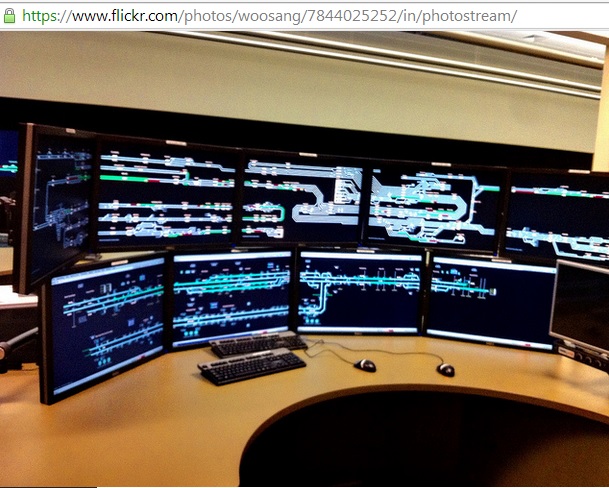
Fig 9: ATRICS work stations at Homebush Control Centre. Location of trains is displayed (via track circuits), signals and points are set by mouse clicks
https://www.flickr.com/photos/woosang/7844025252/in/photostream/
Fig 10: ATRICS coverage Nov 2014.
http://www.asa.transport.nsw.gov.au/sites/default/files/asa/engage/20141105%20Presentation%204%20-%20Vince%20Modafferi%20%20-%20ATRICS%20Roadmap.pdf
Note that large areas West of Auburn are not covered yet. This shows that there is more urgent work to do than to dismantle a system which is on a higher level of train protection.
In the original 2011 NWRL project definition report it said in chapter 4.8.1
“Trains will be controlled using the RailCorp Automatic Train Running Information and Control systems (ATRICS) or equivalent, allowing continuous monitoring, communication with and control of the trains.
The control system will also have the capability to interface with the current RailCorp Train Management systems. Stations and other facilities will be managed by the NWRL control system.”
http://www.nsw.gov.au/sites/default/files/NorthWestRailLinkProjectDefinitionReport.pdf
In order to appreciate how many signals would be removed, have a look at this diagram (Drivers Route Knowledge – as of July 2014):
Fig 11: Conventional multi aspect colour light signals in ECRL tunnel between Macquarie Park and North Ryde station (fixed blocks)
https://railsafe.org.au/handbooks-guides-diagrams-signal-box-list-and-registers
Dual directional signalling throughout the length of the line provides for bypassing any line blockage within the ECRL, and the clearing of trains under signals against the normal running direction.
Just the enabling work to connect the ECRL with the rest of the rail system at Epping and Chatswood cost $170m. Extract from the website of Rail Planning Services:
Epping – Chatswood Rail Link Interface Works
Staged relocation and introduction of signal, civil, track, communication, electrical HV and overhead wiring infrastructure assets in the live rail environment, to enable the ECRL to tie into the existing rail network with no disruption to existing RailCorp services.
These project works involved the direct management of the construction of over $170M of rail infrastructure in the live rail corridor. http://www.railplanning.com.au/depth.html
All this will be removed while there is much more urgent upgrading work to do in the rest of the network.
Conclusion:
To introduce non-compatible rolling stock to Sydney’s rail system is like building new tracks with a different gauge. 19th century.
To be continued
In part 2 we are going to look at the progress of introducing automatic train protection in Sydney and where the NWRL fits in.
4/1/2015
Sydney mismanages transition to driver-less single deck trains (part 2)
http://crudeoilpeak.info/sydney-mismanages-transition-to-driver-less-single-deck-trains-part-2
Previous posts related to rail:
21/12/2012
Last X’mas train from Sydney to Newcastle CBD
http://crudeoilpeak.info/last-xmas-train-from-sydney-to-newcastle-cbd
28/5/2012
NSW regional railway clock stopped at midnight but Hunter coal trains are rolling
http://crudeoilpeak.info/nsw-regional-railway-clock-stopped-at-midnight-but-hunter-coal-trains-are-rolling
30/4/2012
NSW Transport Master Plan debates conventional peak oil 2006, assumes continuing oil age
http://crudeoilpeak.info/nsw-transport-master-plan-debates-conventional-oil-peak-2006-assumes-continuing-oil-age
5/2/2012
Australian peak oil report ignored for urgent Sydney Canberra rail upgrade (Peaky Leaks Part 2)
http://crudeoilpeak.info/australian-peak-oil-report-ignored-for-urgent-sydney-canberra-rail-upgrade-peaky-leaks-part2
5/12/2011
Australian intercity rail run-down and unprepared to replace domestic flights after peak oil
http://crudeoilpeak.info/australian-intercity-rail-run-down-and-unprepared-to-replace-domestic-flights-after-peak-oil
